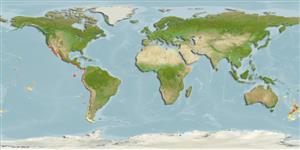Environment: milieu / climate zone / depth range / distribution range
Ecologia
marino batidemersale; distribuzione batimetrica 13 - 384 m (Ref. 2850). Deep-water; 36°N -
Eastern Pacific: California, USA to Isla Lobos de Tierra, Peru and the Galapagos Islands. Rare north of central Baja California, Mexico (Ref. 2850).
Size / Peso / Age
Maturity: Lm ? range ? - ? cm
Max length : 32.0 cm TL maschio/sesso non determinato; (Ref. 9353)
Found on bottom. Feeds mainly on other fishes. Young are pelagic and eaten by large predatory fishes such as tunas. Spine above pectoral fin probably slightly venomous.
Life cycle and mating behavior
Maturità | Riproduzione | Deposizione | Uova | Fecundity | Larve
Eschmeyer, W.N., E.S. Herald and H. Hammann, 1983. A field guide to Pacific coast fishes of North America. Boston (MA, USA): Houghton Mifflin Company. xii+336 p. (Ref. 2850)
IUCN Red List Status (Ref. 130435: Version 2024-1)
Threat to humans
Venomous
Human uses
Pesca: commerciale; Acquario: Commerciale
Strumenti
Special reports
Download XML
Fonti Internet
Estimates based on models
Preferred temperature (Ref.
123201): 10.8 - 19.5, mean 14.5 °C (based on 96 cells).
Phylogenetic diversity index (Ref.
82804): PD
50 = 0.5020 [Uniqueness, from 0.5 = low to 2.0 = high].
Bayesian length-weight: a=0.01738 (0.00949 - 0.03182), b=3.07 (2.90 - 3.24), in cm total length, based on LWR estimates for this species & (Sub)family-body (Ref.
93245).
Trophic level (Ref.
69278): 4.3 ±0.71 se; based on food items.
Generation time: 3.4 ( na - na) years. Estimated as median ln(3)/K based on 1
growth studies.
Resilienza (Ref.
120179): Medio, tempo minimo di raddoppiamento della popolazione 1.4 - 4.4 anni (K=0.32; tm=2-3).
Fishing Vulnerability (Ref.
59153): Low to moderate vulnerability (35 of 100).
